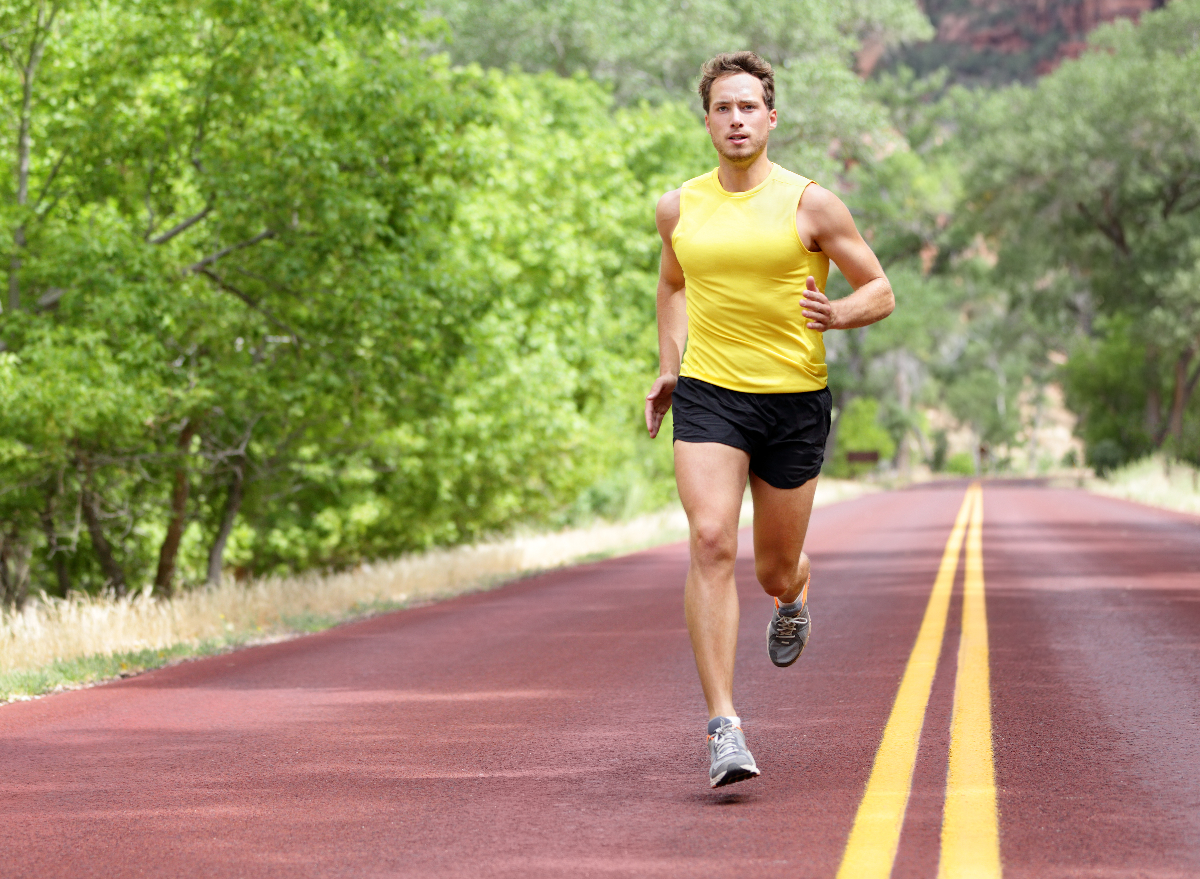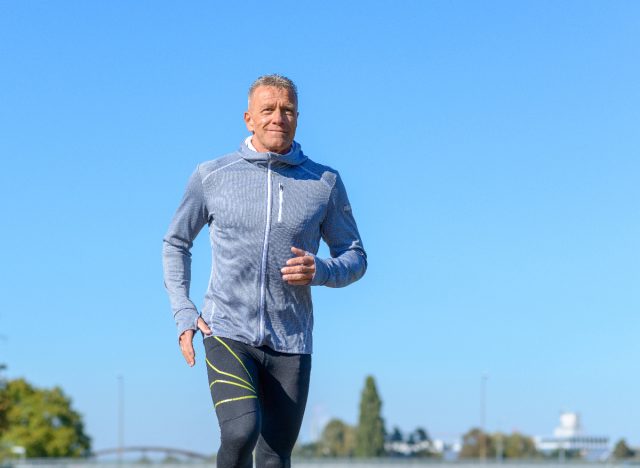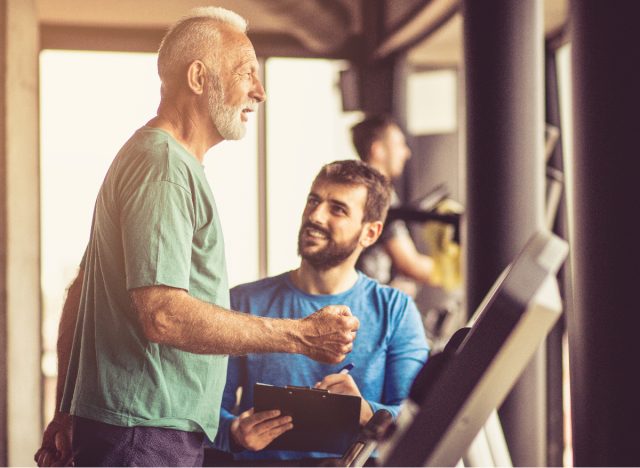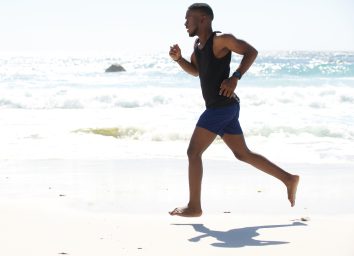The Beginner’s Guide To Training For Long-Distance Running

If you’re ready to dust off the old running shoes from the back of your closet and try out a new exercise routine, then you’ve come to the right place. Running is a great form of cardio that can reap a number of health benefits, such as (but not restricted to) weight loss, stronger muscles, stronger bones, and improved cardiovascular functionality. Unfortunately, a lot of the time, getting started is the hardest part. So, with the help of an expert, we’ve put together a beginner’s guide to training for long-distance running.
Regardless if you’re looking to train for a marathon or just aiming to run for long periods of time, pretty much all the same rules will apply. To truly see improvement in your running skills, it will take practice and a program that includes “mobility, strength, [both] long and short runs, and lots of skill/drill practice,” according to Stephanie Buettner LMT, CPT, a certified running coach for Technique Specialists.
While long-distance running doesn’t happen overnight, there are a couple of steps that can help you get moving in the right direction and reach your goals in no time. One day and one mile at a time! Continue scrolling for the beginner’s guide to long-distance running, and next, be sure to check out The 6 Best Exercises for Strong and Toned Arms in 2022, Trainer Says.
Your footwear plays a part

Picking the shoes you wear for running may seem like a simple task—some kind of sneaker or workout footwear— but sometimes, it’s a bigger deal than it seems. Finding the correct size, weight, comfort, and longevity are all things to consider when setting yourself up for success out on the trails.
If you choose shoes that don’t properly support your body or your running goals, then you can place yourself at risk for injury. Wearing “minimalist shoes,” for example, can potentially increase your chances of experiencing pain when running, according to studies noted in The American Journal of Sports Medicine.
Your best bet is to “stop at a local running store, and they will look at you moving and recommend a good running shoe,” Buettner says. Consider the wide range of running shoe options on the market, and don’t be afraid to ask the experts for help.
Related: The Most Productive Floor Exercises To Get Rid Of A Flabby Stomach, Trainer Says
Consider form over distance

When you’re just starting out, you may not be able to run a marathon all in one go. And that’s totally okay! “Don’t do junk miles,” Buettner explains. You shouldn’t be struggling to run long distances just to say you ran “x” amount of miles. Distance is not going to get you where you want to go, but consistent form will.
It’s best practice to direct your focus on quality over quantity. Buettner suggests, “If you run injury-free and efficiently, you don’t need tons of miles to practice for Marathons or Ultras.”
Proper running form depends on fully developed strides, a strong core, consistent breathing technique, and good body posture. One study found that when runners have strong form, it not only optimizes running movements, but it also enhances their overall performance. So, when you’re training for long-distance running, keep your head and chest up, activate that core, and make sure your arms are relaxed (via Healthline).
Related: The 5 Best Floor Exercises To Increase Your Visceral Fat Burn, Trainer Says
Fluids throughout the day

Hydrating your body is a crucial part of daily life and even more important when you’re participating in any athletic activity. That includes before and during your workout, and especially when you’re in recovery following your sweat session.
If you’re not efficiently hydrating your body with water and fluids, your performance will decline, Buettner says. For peak performance, it’s recommended to consume 10 to 15 ounces of fluid before your run (10 to 15 minutes before, to be exact), in addition to every 20 to 30 minutes while you’re on your run, according to the American Academy of Orthopaedic Surgeons (AAOS).
Along with hydrating your body with water, Buettner suggests adding fluids with electrolytes to support your body for long-distance running. Choosing beverages that benefit your body like sports drinks or electrolyte supplements (tablets or powder to be added to water), can contribute to your body’s overall hydration and progression towards your individual goals.
Related: The 3 Warm-Up Exercises You Should Do Before A Cardio Workout
Consistently fuel your body

While introducing more water and electrolytes to your body is very important, high-intensity activities—such as running—also require a healthy diet. “Just like a car,” Buettner explains, “change the oil otherwise the car isn’t running very well … refueling with good quality food and your body recovery is supreme.”
Choosing high “energy-rich food” will supply your body with what it needs to maintain itself and help you progress in your training, she tells us. Instead of reaching for empty-calorie foods like chips or pizza, pick up a healthy snack that checks off all the main body-fueling categories.
For long distance-runners in particular, you’ll need to stock up on key nutrients to give your body energy, specifically protein, fat, and carbohydrates, according to Mayo Clinic. Whether it’s a protein bar, cheese and crackers, or some cottage cheese and fruit, you will find your performance can improve if you feed your body substantial foods.
Ask for help from an expert

You can also find someone with the experience and knowledge to guide you through the process of long-distance running. Getting a running technique coach will help put you on a structured program where you progress over a certain length of time, Buettner says.
Your program may begin with light jogging or walking at an incline to get your body situated with basic movements. Running is a skill that needs to be learned over time, she explains, “like one would hire a golf or Tennis coach!” They can also teach beginners better form, construct individualized workouts for strength, lay out the best drills to practice your technique on your own time.









